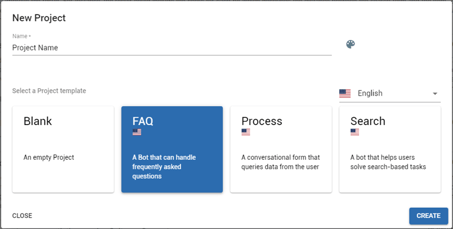This week, we announced the release of Cognigy.AI 3.4 - the newest release of our industry-leading Conversational Automation Platform.
Webinar auf Deutsch? Hier klicken!
As always, the release is jam-packed with amazing new features - including the most comprehensive Microsoft Bot Framework Integration in the market. We’ve also added innovative productivity enhancements and new additions to AI management.
Cognigy.AI 3.4 was built to make the creation, deployment and maintenance of conversational automation solutions - both customer- and employee-facing - as easy as possible.
Here's what we’re announcing today:
- Microsoft Bot Framework integration
- Full support for Adaptive Cards
- Typescript in Code Nodes
- Project Templates
- Rich Default Replies
- New Intent Management features
- Intent Trainer import/export
- New Channel Endpoints
- Customizable Analytics
- Kubernetes Support
- Extended Injection API
Here are the details…
Microsoft Bot Framework integration
Microsoft's answer to conversational AI is the Microsoft Bot Framework, essentially consisting of four components:
- Channels (e.g. Teams, Skype for Business, etc)
- Azure Bot Services (Azure service to handle chat messages)
- Chat Logic in Code using Bot Framework SDKs
- LUIS for NLU
While an amazing framework overall, the big shortcoming is the inability for business users, the owners of the automated processes, to make changes to the bots themselves. All logic resides in code and unless you can write code, you're out of luck. This is where Cognigy.AI comes in, adding our graphical editor to the mix to empower business users to create and manage conversations in a user-friendly way.

The new feature that enables this is the Microsoft Bot Framework Endpoint, which can be spawned directly inside the Cognigy.AI user interface.
Full support for Adaptive Cards
When it comes to chat user experiences, sometimes it's not enough to just send text. Even sending the pre-packaged graphical components some channels offer (e.g. galleries, images, quick replies) aren't enough. To solve this problem, Microsoft released Adaptive Cards an open framework for advanced, portable chat user interfaces.

Cognigy.AI now has full support for Adaptive Cards for various channels, including Bot Framework, Teams and the Cognigy Webchat. The UI has been extended to include live previews of cards, so you can see the cards you're building in real time.
Typescript in Code Nodes
Cognigy.AI allows developers to execute code directly within a conversation. This code is written in Code Nodes, which have always supported JavaScript, complete with Intellisense and more. We've now added full support for Microsoft Typescript to Cognigy.AI, making it possible to write type-safe code and be more productive.
Project Templates
Customers looking for a way to get started with their projects more quickly can now make use of Project Templates.

Cognigy.AI offers three Project Templates in English and German:
- FAQ (for bots that handle frequently asked questions)
- Process (for bots that collect information from a user)
- Search (for bots that collect search parameters and trigger a search in a 3rd party system)
Rich Default Replies
When an intent is detected, Cognigy.AI can send a Default Reply to the user, meaning that the Flow itself won't be executed, but a predefined answer will be sent to the user instead. These Default Replies have traditionally been pure text, but can now make use of the full power of Cognigy.AI's channel-specific replies. You could for example send a picture and buttons on a webchat, output a specially formatted voice blurb on Alexa or show an Adaptive Card on Microsoft Teams, all from within the intent editor.
New Intent Management features
Intent Management is one of the most important tasks when it comes to creating Conversational AI. We've added several features in this version to make creating and editing intents even easier, such as the tagging and searching of intents.
As for the NLU itself, we added the ability to use system slots in example sentences and the newly created Any Slot. These newly-created slots allow you to detect slots dynamically based on patterns. You could define an example sentence like "I want to eat a <<food>>" and upon receiving "I want to eat a pizza", pizza would be detected as a food slot.
Intent Trainer import/export
The Intent Trainer allows a bot editor to see the user inputs which haven't been understood and then use those inputs to re-train the bot to create a better performing model.
We've added various improvements to the Intent Trainer, plus the ability to export and import records. This makes it possible to move them between environments.
New Channel Endpoints
Cognigy is always striving to add more channel endpoints to our solution, to allow our customer's users to communicate with Cognigy.AI in even more ways. In this release we've added new Endpoints for:
- Microsoft Bot Framework
- Ringcentral Engage
- Smooch
- Twilio Autopilot
- Userlike
Customizable Analytics
When managing a bot, it is important to measure how well it is doing. Cognigy.AI has always made it easy to integrate with systems like PowerBI, Tableau or Qlik by exposing its data as ODATA.
Cognigy.AI 3.4 builds on top of that by giving our customers the ability to customize what analytics data is actually saved. It allows for the addition of arbitrary data to the analytics collection and, in that way, enables storing very use case-specific information, while still exposing it to the analytics tool of your choice. That way you could, for example, store a user’s chosen city for a booking or the current weather of the day, anything you might need in your BI.
Kubernetes
On the infrastructure side, Cognigy.AI now fully supports Kubernetes deployments, whether on OpenShift, Amazon EKS or Azure AKS.
The out-of-the-box support means that installations and upgrades will be even more seamless than before, making it easier for dev ops to manage Cognigy.AI deployments.
Extended Injection API
The Injection API enables external systems to inject information back into a running Cognigy.AI session after an arbitrary timespan. This can be a minute, an hour or a day. When the third-party system calls back, Cognigy.AI will process the input and send an answer to the user.
This is especially vital when integrating with the long-running processes of RPA systems like Kofax or UiPath.
Summary
Our solution makes it easier than ever to build, deploy and manage conversational AIs at scale from a centralized conversational platform. Our tools enable business users to develop solutions in customer experience, customer support and process automation, while giving developers the power to customize the solution to their liking. Cognigy.AI 3.4 adds further to this vision and we’re looking forward to seeing what our customers and partners around the world will build with it.




.png?width=60&height=60&name=AI%20Copilot%20logo%20(mega%20menu).png)




